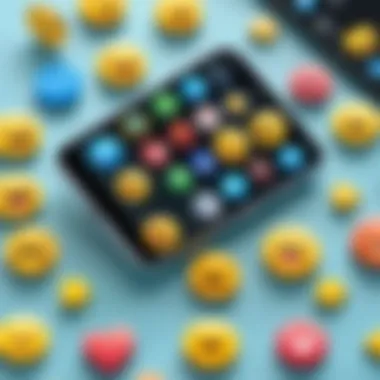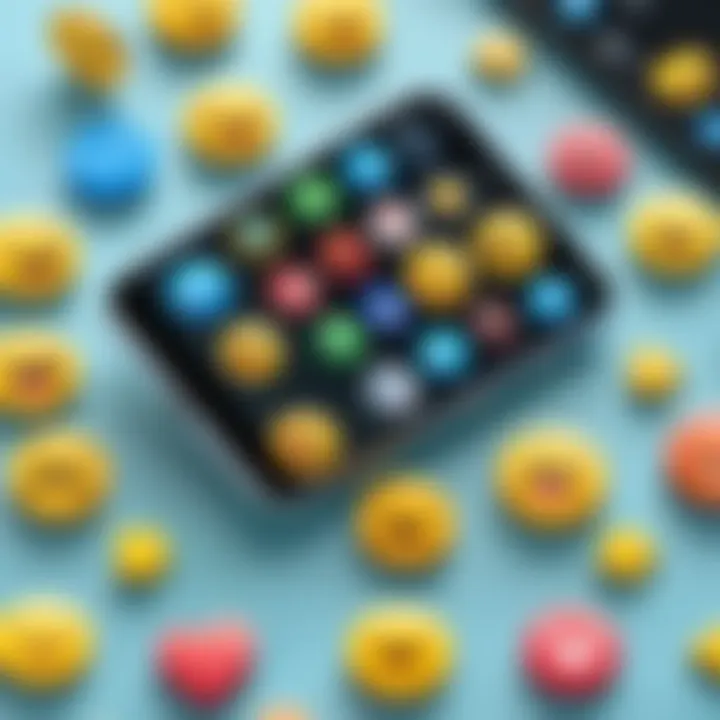Exploring Cute Emojis: Acquisition and Usage Tips


Intro
In a world increasingly dominated by digital interactions, the significance of effective communication cannot be overstated. Emojis have emerged as a playful and visual form of expression that enhances conversations across various platforms. Since their introduction in the late 1990s, emojis have evolved remarkably, reflecting cultural nuances and personal sentiments. With the sheer volume of emoji options available today, understanding how to acquire and utilize these little symbols is essential. This article dives into the methods of accessing cute emojis and explores practical tips for incorporating them into daily chats, revealing not just their aesthetic appeal but also their role in the nuanced dance of human communication.
Overview of the Technology
Emojis stem from a complex blend of technology and creativity. They are more than just images; they encapsulate emotions, ideas, and social contexts in a compact form. The technology behind emojis is rooted in Unicode, a standardized encoding system that enables the consistent representation of characters across different devices and platforms.
- Key specifications: Each emoji is encoded by a unique Unicode point, allowing it to display correctly on various operating systems, mobile devices, and applications. As such, an emoji sent from an iPhone will appear the same on a Samsung device, as long as the platforms are updated. The Unicode Consortium is responsible for adding new emojis, frequently based on user suggestions and cultural relevance. This adaptability ensures that emojis stay current and inclusive.
- Unique selling points: One might argue the most charming trait of emojis is their versatility. They can convey feelings, clarify intentions, and even enhance storytelling. Particularly in a text-heavy society, these icons bridge gaps that words might leave. For example, a 🌼 flower can brighten a message, while a 😅 sweat smile can soften the blow of criticism. Integration with various apps allows for creativity in their use—everything from customizing emojis in Slack to utilizing animated versions in social media like Facebook can elevate communication.
Design and Build Quality
While emojis may seem simplistic at first glance, their design plays a pivotal role in user engagement. This accessibility can be attributed to several factors
- Material used: Emojis are digital constructs, composed of pixels and vectors generated by graphic designers. They are designed specifically for easy recognition and user-friendliness. The color palettes are chosen to evoke specific emotions, while their size and simplicity ensure they work well across devices, from smartphones to laptops.
- Ergonomics and usability: Emojis must balance artistic design with functionality. The most widely used emojis are those easily distinguishable at a glance. The trend towards flatter designs rather than overly detailed graphics makes them not only visually appealing but also easy to integrate into texts without overwhelming the message.
"The charm of emojis lies in their ability to express nuanced feelings in a compact form, transforming digital conversations into colorful exchanges."
Prelude to Emojis
In today's digital landscape, emojis have marched straight into the center of our communication style. They act as visual cues, adding layers of meaning and emotion to our texts, Tweets, and posts. Understanding emojis is not simply a matter of knowing which image represents what. Rather, it’s about grasping their significance in enriching interactions and ensuring messages hit home. Emojis have become such a staple in our conversations that leaving them out can feel like missing the spices in a well-cooked dish; they just bring everything to life.
Whether you’re sending a quick message to a friend or drafting a professional email, mastering the art of emoji utilization can enhance clarity and convey feelings that plain text might fail to express. They’ve jumped from the realm of digital novelty into an essential aspect of personal and professional expression, taking on cultural dimensions and evolving with the times.
Understanding Emojis and Their Importance
The value of emojis in digital communications cannot be stressed enough. They serve not only as fun, colorful additions but as effective communication mediums. When faced with limitations of traditional text, emojis provide context that can make even the simplest sentence resonate with greater emotion. For instance, a simple phrase like "Good luck" can easily be transformed by adding a few cheerful emojis, making the sentiment feel warmer and more supportive.
Furthermore, emojis are a universal language to a certain extent. People across different cultures and languages often comprehend their meanings, which makes them invaluable in bridging communication gaps in a globalized world. It’s almost like a secret handshake; once you know the code, you can enjoy an unspoken rapport with others.
The Evolution of Emojis
If you trace the roots of emojis, you find a fascinating journey that mirrors our technological advancements. Originating in Japan during the late 1990s, emojis were initially designed for mobile devices to convey information succinctly. Over the years, these small images have morphed, catering to the growing demands of users who craved richer emotional expression. Today's emojis are more sophisticated, encompassing a myriad of emotions, activities, and cultural symbols, reflecting diversity and inclusion.
Evolving from basic smiley faces to a vast library of characters that includes everything from animals to food items, the journey of emojis signifies our growing need for visual communication. New categories emerge with every major update in software and mobile operating systems, often driven by social trends and rather rapid shifts in our lifestyle.
In summary, emojis are far more than whimsical decorations. They encapsulate feelings, contexts, and identities in a single image, making them potent tools for effective communication. Their relevance in today’s tech-savvy world is irrefutable, paving the way for expressive and engaging interactions that continue to evolve with us.
Exploring Platforms for Cute Emojis
In today’s fast-paced digital landscape, emojis have become not just a luxury, but a necessity in communication. They add color and warmth to our conversations. With emojis, a simple message can take on a whole new life. Consequently, exploring various platforms for cute emojis is crucial. Each platform offers its own flavor and unique features that can enhance our emoji communication experience.
Popular Social Media Platforms
Facebook stands out in the social media jungle for its robust emoji framework. Here, emojis aren’t just for personal expressions; they’re an integral part of user engagement. The platform introduces emoticons in reactions, allowing users to express a range of emotions—from love to laughter—all at the touch of a button.
A noteworthy characteristic about Facebook is its vast user base. This massive community means that emojis can serve as a universal language, breaking down barriers. However, one drawback is that while Facebook supports thousands of emojis, it tends to favor a few over others. This can skew perception as not all emojis get equal limelight.
On Instagram, cute emojis become visual storytelling tools. People use them in captions, stories, and comments to add flair and convey feelings more vividly. The platform’s emphasis on aesthetics makes the use of emojis almost an art form.
The uniqueness of Instagram lies in its integration of creative design. Enhancing photos or videos with emojis offers a fun way to capture attention. However, as the platform evolves, some users feel inundated with trending emojis, which sometimes overshadows personal expression.
Twitter packs its punch in brevity; here, emojis act as linguistic shortcuts to enhance tweets. Given that every character counts, the judicious use of emojis can convey tone and emotion without extending the text. It is a popular choice, especially among users who aim to make impactful statements quickly.
A key feature is the real-time interaction that Twitter provides. Emojis act as catalysts for engagement, making tweets feel more relatable. But on the flip side, tweets can sometimes drown in an ocean of emojis, making the core message hard to decipher.
Messaging Applications
WhatsApp is a premier messaging app where emojis play a vital role in conveying tone in text exchanges. With an emoji keyboard at your fingertips, it allows users to embellish their messages, making them more expressive. Its end-to-end encryption adds a layer of safety, ensuring your adorable exchanges remain private.
A standout characteristic of WhatsApp is the simplicity of its interface. Users can send emojis individually or as reactions, making response time swift. However, the downside is that certain emojis may appear differently on different devices. This disparity can lead to confusion or miscommunication in a group chat.
Telegram
Telegram takes a different route, allowing users to uncover a treasure trove of emojis. It supports animated emojis, bringing an extra level of delight to messaging. Telegram’s sticker packs are also a creative touch, inviting users to express themselves in truly unique ways.


This platform is ideal for those who seek a customizable experience. Users can even create their own stickers or emojis, making it a fun playground for creators. The catch is that its advanced features may not be as user-friendly for those accustomed to traditional messaging apps.
Discord
Discord, initially created for gaming communities, has expanded its reach, incorporating various chat functionalities, including emoji configurations. The platform allows users to upload bespoke emojis, fostering an environment of self-expression. This characteristic makes Discord particularly appealing to niche communities where personalized communication is the norm.
The unique aspect of Discord is its layering of forums and chat channels, providing a multifaceted communication experience. On the downside, the learning curve can be steep, especially for users unfamiliar with the interface.
In summary, exploring emoji platforms isn’t just about accessing images; it’s about understanding the nuances each platform brings to communication. They contribute immensely to the richness of how we convey emotions and engage with others.
Utilizing Built-in Emoji Libraries
In today's digital landscape, the integration of adorable emojis plays a pivotal role in enhancing communications. Utilizing built-in emoji libraries offers users a seamless way to access a plethora of visuals without the need for third-party applications. The convenience of these libraries streamlines the emoji acquisition process, enabling individuals to express emotions and ideas effectively in their digital interactions. Let's break down how to access these libraries and how to make the most out of system emojis.
Accessing Emoji Keyboards
Mobile Devices
Mobile devices, such as smartphones and tablets, have fundamentally transformed how we communicate. The emoji keyboard is typically just a couple of taps away, making it an indispensable tool for many users. One key characteristic of mobile devices is their intuitive touch interfaces, which allow for quick and easy emoji insertion into messages.
This easy access makes mobile devices a popular choice for many. With the wide adoption of messaging apps and social media on these platforms, emojis have become nearly second nature. A unique feature of mobile devices is the ability to use custom keyboards, which can provide even more options beyond standard emojis. The main advantage here is versatility; however, overuse can lead to discussions becoming muddled or overly expressive, which might not always convey the intended message.
Desktop Systems
When it comes to desktop systems, the approach to using emojis can differ significantly. Desktop systems usually boast larger screens and more robust processing capabilities. Users can often access emojis through character maps or built-in functions, underlining the characteristic diversity of interface designs. With functions such as copy and paste, desktops allow for easier browsing and selection of emojis from various catalogs.
This characteristic makes desktop systems beneficial for users who are working on longer texts or multimedia presentations. However, a unique feature of desktop systems can also act as a double-edged sword; sometimes, emojis can get lost amongst a sea of text, potentially diluting their impact. There are advantages to desktop use but balance is key to maintain clarity.
Leveraging System Emojis
Leveraging the emojis designed and integrated by your device's operating system can significantly improve communication quality. One of the considerable benefits of this approach is compatibility; system emojis are designed to work seamlessly across various applications without issues of rendering or compatibility that often plague custom emojis.
They also provide a standardized way to express emotions, reducing confusion that could arise from different versions of the same emoji. This consideration is vital, particularly in settings where concise communication is crucial, such as professional emails or group chats.
Furthermore, system emojis tend to update with operating system updates, allowing users to benefit from new additions and improvements. While they may not offer the personalization of custom emojis, their universality and ease of access make them a fundamental aspect of digital expression.
"Emojis bridge the gap between words and emotions, making our digital conversations richer and more expressive."
Embracing built-in emoji libraries not only enables more effective communication but also enriches our interactions, ensuring our messages carry the nuances that words alone may miss. With an understanding of how to utilize these tools both on mobile devices and desktop systems, users can effortlessly enhance their digital exchanges.
Custom Emoji Creation
In the age of digital communication, custom emoji creation has emerged as a significant trend, allowing individuals to express their personalities and emotions in unique ways. This bit of digital art serves not just as a fun addition to messages but also as a personal branding tool. When you create your own emojis, you have the power to convey feelings or concepts that might not be adequately represented by standardized emojis. This makes your digital conversations richer and more engaging.
Apps for Designing Emojis
Bitmoji
Bitmoji is one of the most well-known apps for designing custom emojis. What sets Bitmoji apart is its ability to create a cartoon avatar that resembles the user. This feature lets people feel more connected to their digital expressions. Bitmoji offers a rich variety of stickers that showcase your avatar in various humorous and relatable scenarios. Since these stickers can be quickly incorporated into apps like Snapchat and messaging platforms, it's clear why many users choose Bitmoji for their personalization needs.
The major advantage of using Bitmoji is the broad range of scenarios it can portray, from casual greetings to seasonal festivities. Its consistent updates keep content fresh and intriguing. However, some users might feel limited by the predefined templates, which could hinder their creativity once they've used a few.
"With Bitmoji, you’re not just sending emojis; you're sharing a piece of your personality!"
Emoji Me
On the other hand, Emoji Me offers a different take on custom emoji design. This app focuses on creating expressive emojis based on the user’s facial features and style preferences. Users can upload their pictures to create a personalized emoji that captures their likeness. A major draw for Emoji Me is its seamless integration across various platforms, allowing users to send their custom emojis effortlessly.
One of the key characteristics of Emoji Me is its emphasis on facial expressions, giving users an authentic digital representation. This can add a layer of depth to communication, enabling more meaningful exchanges. However, while Emoji Me excels in personal likeness, it may not offer the extensive library of scenarios that Bitmoji boasts.
Using Graphic Design Software
Utilizing graphic design software for emoji creation is another viable avenue for those looking to go beyond apps. People with a knack for design might find programs more aligned with their creative vision. This section explores two popular graphic design tools.
Adobe Illustrator
Adobe Illustrator stands out in the graphic design world for its powerful vector graphics capabilities. When it comes to custom emoji creation, Illustrator allows users to create detailed and scalable designs, ensuring your emojis look sharp on various screens. The program offers a vast array of drawing tools that can cater to both novice and expert designers.
Its advantages include precision in design and the ability to create unique, original emojis that can be used in any context, making it a popular choice among graphic designers. However, the learning curve may be steep for beginners, as it requires a certain level of familiarity with graphic design techniques.
Canva
On the other side, Canva simplifies the graphic design process, making it accessible to all skill levels. Ideal for those who may not want to delve deeply into complex design software, Canva provides pre-made templates that can easily be customized for emoji creation. Users can select shapes, colors, and fonts, making it easy to craft emojis that resonate with their audience.
The advantage of using Canva is its intuitive interface, making the design experience enjoyable and straightforward. Yet, some may find its limited free features a drawback, as advanced templates and graphics typically come with a cost.


Trendy Emoji Styles
Emojis have morphed from simple icons into a language of their own, imbued with layers of meaning and context. The trendy emoji styles today signify more than just a face or object; they encapsulate sentiments, moods, and cultural nuances. Understanding and utilizing these styles can greatly enhance the way we communicate digitally. Trendy emojis reflect current societal trends, seasonal sentiments, and cultural diversity, all of which enrich our digital conversations and help us connect on collective experiences.
Seasonal and Holiday Emojis
As seasons change, so too does the emoji landscape. Seasonal and holiday emojis serve as a vibrant representation of our celebrations and the changing of the year. Notably, during winter, you might notice an uptick in snowflakes, Christmas trees, and even festive food items like gingerbread or hot chocolate. These emojis are not merely decorations—they foster connection and community spirit during holidays. They help express feelings that words sometimes can't quite capture.
When sending messages during a holiday, using relevant emojis can instantly elevate your mood and convey a sense of festivity. For instance, a simple message wishing someone a Merry Christmas can transform into something more heartfelt when accented with 🎄, 🎁, and 🎉. Such inclusions make the communication warmer and more personal.
Think about how the usage of emojis can vary from one holiday to another:
- Valentine's Day: 💝, 💘, 😘
- Halloween: 🎃, 👻, 🕷️
- Thanksgiving: 🦃, 🍂, 🍰
These emojis tap into the feelings associated with each occasion, enhancing the emotional depth of your messages. As cultures continue to blend and evolve, seasonal emojis will likely reflect broader festivities and new traditions.
Cultural and Regional Variations
Diving deeper into the cultural and regional variations in emoji use can also reveal some fascinating insights. Different cultures have distinct customs, celebrations, and even sense of humor, which is often reflected in their unique emoji adaptations. For example, while the standard thumbs up emoji (👍) is a universal sign of approval, in some cultures, it might not hold the same positive connotation.
Examples of cultural emoji representations might include:
- The use of specific foods or dances relevant to certain cultures.
- Symbols or icons that signify significant milestones or traditions, like the 🥘 emoji related to paella in Spanish culture.
In regional contexts, some emojis may be created or adapted to resonate more with local demographics. Take for example, the various skin tone options available for many emojis, which allow users to choose representations that resonate with their personal or cultural identity. This enhances relatability and promotes inclusivity, enabling a richer communication experience.
Understanding these variations can broaden one's appreciation for emoji usage in digital interactions. It sheds light on how emojis can serve as a bridge across different backgrounds and experiences. They are not just cute pictures; they are reflections of identity, celebration, and community.
"Emojis are a digital expression of human emotion that take on unique meanings in various cultural and social contexts."
Ultimately, seasonal trends and cultural adaptations provide endless opportunities for creativity in communication. They create spaces where dialogue is infused with shared cultural elements, making the digital environment lively and relatable.
Integrating Emojis into Communication
In today's fast-paced digital era, the way we communicate has transformed significantly. Enter emojis—small images overflowing with emotions. They have become more than just visual embellishments; they play a critical role in enriching our communications. Emojis serve as a universal language that transcends barriers, allowing us to express feelings that words alone sometimes struggle to convey. In this section, the focus is on understanding just how essential these cheerful little icons are in both professional and casual settings.
Effective Emoji Use in Professional Settings
When it comes to professional communication, integrating emojis can be a double-edged sword. Used wisely, they can break the ice and bring a touch of warmth to otherwise sterile messages. For example, a simple smiley face at the end of an email can soften a tough critique, helping to ease the recipient's reception of the message. However, it's crucial to gauge the context and audience. Here are some tips for effective emoji use in work environments:
- Know Your Audience: Different demographics react to emojis differently. A tech-savvy startup team might embrace them, while a law firm might prefer a more traditional approach.
- Use Sparingly: Overusing emojis can dilute your message. A well-placed emoji can add flavor, but too many can reduce professionalism.
- Complement, Don’t Replace: Emojis should enhance your message, not replace your words. They can be used to emphasize key points but shouldn’t be relied upon as the primary means of expression.
- Stay Within Company Guidelines: Some organizations may have specific policies regarding emoji use. It’s advisable to stay informed about any such rules.
Casual Communication with Emojis
In more laid-back environments, the use of emojis is largely celebrated and often expected. In casual chats, emojis work like magic to convey humor, excitement, or even sarcasm. They enliven conversations and can smooth over misunderstandings. Consider this: a simple text like "I can’t believe you ate my sandwich 😱!" comes across much differently than just the words alone.
- Express Emotion: Emojis accurately portray feelings when tone and body language are absent. A sad face can hang heavy on a text message, letting your friends know you're feeling blue without needing to say a word.
- Brevity is Key: In a world where time is limited, emojis can make communication quicker. A thumbs-up can mean acknowledgment or agreement, cutting out unnecessary sentences.
- Customize Your Personality: Emojis allow users to express individuality. From a wild-eyed emoji to one with heart-shaped eyes, these icons can depict a person’s unique style and flair.
- Foster Engagement: Incorporating emojis into social media posts can increase interactions. Posts sprinkled with emojis often garner more attention and likes than their text-heavy counterparts.
To wrap it up, incorporating emojis into casual communication generates a richer, more colorful narrative. It's about building relationships and expressing oneself completely in a landscape that can often feel too rigid.
"Emojis help us articulate our feelings more fluidly than words often allow, making them an invaluable tool in both professional and casual conversations."
Integrating emojis into communication isn't just for fun; it’s about enhancing understanding and connection in our increasingly digital landscape.
Emojis and Digital Expression
In today's fast-paced digital world, emojis are more than just colorful images gracing our screens—they're a vibrant means of expression. The significance of emojis transcends mere decoration; they infuse messages with layers of emotional nuance and relatability. Consider how a simple smiley face can lighten the tone of an otherwise dry message or how a heart can convey warmth when words fall short. They provide relief from the sterility of text, adding a visual dimension that makes communication more lively.
Emojis also play a crucial role in bridging gaps in communication. When context gets tangled in digital conversations, emojis can step in as signposts, clarifying intent and moods. They not only capture feelings but also build connections, making exchanges feel personalized and engaging. In a landscape where messages are often dissected and misread, emojis serve as a lifeline, enhancing clarity and empathy.
The Psychology Behind Emoji Usage
Understanding the psychology of emojis reveals why they resonate so strongly in our communications. At the core, humans are visual creatures, wired to respond to imagery faster than text. Emojis tap into this innate preference, relying on universally recognized symbols that evoke immediate emotional responses. When sending or receiving an emoji, the brain interprets this visual input almost instantaneously, leading to quicker emotional recognition.
Research has indicated that emojis can even influence how we perceive the tone of a message. For instance, the use of a playful emoji can soften a critique, making feedback seem less harsh. Furthermore, individuals tend to express themselves more freely, often conveying sentiments through emojis that they might hesitate to articulate with words. This can lead to richer, more nuanced conversations, where the depth of expression could rival face-to-face interactions.
"Emojis allow individuals to express subtle shades of meaning, enhancing both the clarity and emotional depth of digital conversations."
How Emojis Enhance Contextual Meaning
Emojis excel at adding context that text alone might lack. Let’s say a friend texts you, "We need to talk!" Without an emoji, this could provoke anxiety or dread. But add a winking face or a laughing emoji, and suddenly the intention shifts from serious to playful. Emojis serve as contextual cues that guide interpretations, reducing the risk of miscommunication.
Additionally, emojis foster inclusivity. Different cultures may interpret symbols uniquely, yet many emojis resonate across boundaries, creating an indie language understood by diverse audiences. They can symbolize feelings or aspects of culture that words might misrepresent or deemphasize.
The effectiveness of emojis in clarifying meaning makes them essential in professional and personal exchanges alike. From marketing campaigns that utilize emojis to connect with audiences to personal messages that feel heartfelt and genuine, the added layer of context can turn a straightforward message into something deeply relatable and engaging.


In summary, emojis are more than decorative; they are central to effective digital communication, enriching our conversations with emotional resonance and contextual clarity.
Challenges with Emoji Representation
In today's fast-paced digital landscape, the delightful use of emojis adds flavor to our communication. However, despite their appeal, emojis can also lead to several significant challenges that are often overlooked. This section examines these hang-ups, particularly focusing on miscommunication and device compatibility issues. Recognizing these hurdles is crucial for anyone who wishes to fully harness the charm of emojis while avoiding pitfalls that can muddle communication.
Miscommunication and Misinterpretation
Emojis are designed to enhance our messages by providing visual shorthand. But not every emoji is universally understood. For example, the widely recognized smiling face may evoke warm feelings for some, while others might find it overly cheerful in a serious context. As a result, misinterpretation can happen more easily than one might think.
Individuals or groups can accidentally convey a message entirely different from what they intended. Think of the ‘thumbs up’ emoji 🚀: it’s used to signify approval in many cultures, but in some places, it might even be taken as an insult. This cultural disparity can present major obstacles, especially in multicultural settings where emojis are exchanged frequently.
Here are some key considerations regarding miscommunication and misinterpretation:
- Cultural Context: Emojis can have differing meanings depending on cultural backgrounds. Awareness of these differences can avoid costly misunderstandings.
- Intended Emotion: Some emojis carry a hefty emotional weight; for instance, a wink may indicate flirtation, yet it could just be playful banter for another.
It's a fine line to walk, and a good practice is asking for clarity rather than assuming the intended meaning behind a chosen emoji. This can help prevent digital faux pas.
"Emojis are like the spices of communication; too much or the wrong kind can spoil the dish."
Device Compatibility Issues
Device compatibility issues represent another layer of complexity in the emoji realm. Not all devices or operating systems render emojis in the same way, leading to scenarios where an emoji looks completely different on an iPhone compared to an Android device. This can lead to confusion as messages can appear jumbled or even lost in translation.
For tech-savvy folks accustomed to seeing the latest emojis on their preferred platform, receiving an emoji from someone utilizing an outdated system can be jarring. For instance, Apple's designs may showcase a more rounded, friendly face, while Google's version is more pixelated, altering the perceived tone altogether.
Here are notable challenges concerning device compatibility:
- Emoji Updates: New emojis occasionally are introduced, but older systems might not support these updates. Users can find themselves stuck using an incomplete set of emojis.
- Rendering Differences: From skin tones to facial expressions, how an emoji is rendered can drastically change its meaning or even affect readability. This inconsistency can inhibit clear communication.
In order to combat these issues, it’s crucial to ensure communication occurs on updated devices and platforms, where possible. By staying attuned to the nuances of emoji representation, users can certainly enhance their digital convos while minimizing missteps.
Being proactive about these challenges can really help strengthen how emojis communicate effectively in a richly diverse digital world.
Future of Emojis
The future of emojis represents a fascinating intersection of culture, technology, and communication. As we look ahead, it's clear that these small symbols will continue to evolve, adapting to the changing landscape of digital interaction. Emojis have become more than just cute images; they encapsulate emotions, context, and cultural nuances in ways that words often cannot. Understanding where emojis are headed is invaluable for anyone seeking to enhance their digital communication.
One key element to consider is the growing necessity for inclusivity in emoji representation. With a broader understanding of diversity, emoji developers are focusing on expanding their offerings to reflect complex human experiences. This means introducing variations that resonate with different communities, whether it be through skin tones, gender representations, or entirely new symbols that represent specific cultural elements. Such developments not only enrich communication but also promote empathy among users from diverse backgrounds.
Another essential benefit of future emoji innovations is their potential to enhance user engagement. In an era where attention spans are short, these expressive icons can captivate audiences in ways text might struggle to. Research shows that content fused with emojis tends to attract higher interaction rates. As businesses increasingly turn to these symbols for branding and marketing, understanding future trends becomes a strategic advantage.
Moreover, as technologies like augmented reality and virtual reality become more prominent, emojis could expand into immersive experiences. Imagine interacting with 3D representations of emojis that respond to real-life gestures and expressions. The ability to personalize and animate emojis in real-time can fundamentally shift how we express emotions digitally.
"Emojis are much like the digital body language of written communication. They fill in the emotional gaps that text can sometimes leave."
This adaptability signifies a deeper understanding of how humanity communicates, and it reinforces the notion that emojis will continue to hold a significant place in our digital lexicon.
Emerging Trends and Innovations
The upcoming changes in the emoji landscape can be divided into several emerging trends that are steadily gaining traction. One of these trends is the integration of emojis in augmented reality experiences. Companies like Snapchat are experimenting with augmented reality filters that allow users to interact with emojis like never before. Users might see emojis floating in their physical environment, enhancing engagement by bringing interaction to life in innovative ways.
Additionally, the rise of personalized emojis is becoming evident. Technologies that allow users to create custom emojis reflecting their facial expressions or unique traits are getting more popular. For example, apps like Bitmoji already cater to this desire. In the future, we may find ourselves using even more refined versions of personalized emojis, which can be made to express our every whim more accurately than before.
Furthermore, the influence of social media trends continues to drive emoji selection. Emojis that align closely with popular memes or cultural phenomena are likely to evolve rapidly. Keeping an eye on burgeoning trends will provide insight into which emojis are on the rise and how we might use them to stay relevant in conversations.
The Role of Artificial Intelligence in Emoji Development
Artificial intelligence (AI) is poised to play a crucial role in the future of emojis. One significant application of AI in this space is in understanding user behavior and preferences. By analyzing how people use emojis in different contexts, AI can suggest the most suitable emojis for specific situations. This predictive capability can streamline communication, making it quicker and more efficient.
Another prospect lies in the ability of AI to identify gaps in emoji libraries and suggest new symbols. As society changes, new concepts and experiences emerge, and AI can help capture these in a timely fashion. The development of algorithms that recognize trending topics and sentiments can guide emoji creators in crafting relevant designs, ensuring emojis reflect contemporary life accurately.
Moreover, AI-powered tools could enable the animation of emojis, leading to more engaging and dynamic ways of expression. Imagine sending a winking emoji that actually winks back at you! Such developments would not only make conversations enjoyable but could also facilitate a deeper form of interaction, bridging the gap between digital and physical communication.
In short, the future of emojis is brimming with possibilities. As technology continues to evolve, so will these tiny icons, becoming even more integral to how we express ourselves in the digital world.
Finale
The conclusion serves as a crucial component of this article, summarizing and synthesizing the extensive discussions surrounding emojis. Understanding the importance of emojis in modern digital communication is more than just recognizing their cuteness; it's about appreciating their role as a bridge in conversations. They can convey emotions and nuances that plain text often fails to deliver. This aspect alone ratifies their presence in every chat, Tweet, or post.
Summary of Key Points
In reviewing our journey through the charming world of emojis, several key points emerge:
- Emojis Enhance Communication: Their incorporation leads to more dynamic interactions, acting as visual cues that frequently supplement or compensate for the lack of tone in written conversation.
- Diverse Platforms: We've explored various platforms and applications where emojis can be accessed and utilized, from mainstream social media sites like Facebook and Instagram to messaging apps like WhatsApp and Discord.
- Custom Creation: The ability to create personal emojis using apps like Bitmoji or design tools such as Canva offers users the chance to add a unique touch to their digital personas.
- Potential Pitfalls: Despite their benefits, challenges such as miscommunication or compatibility issues remain pertinent.
- Future Trends: As technology advances, so too does the use of emojis, with emerging trends like AI-generated emojis showing promise in further enriching digital dialogue.
Encouragement for Exploring Emojis
In closing, we encourage readers to delve into the vast array of emojis available to enhance their digital conversations. Start by experimenting with built-in emoji keyboards on your devices. Try exploring different messaging platforms to unearth diverse emoji selections. Don't shy away from customization; designing your own emojis can be a fun way to express your individuality.
Emojis are not just bits of graphics; they are tools for communication in our increasingly digital world. So, embark on this colorful journey. Each emoji you choose has the potential to add vibrancy to your messages and make your conversations come alive. Remember—life’s too short for plain text!







